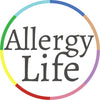Dimi's Allergy Story- Allergies, My Daughter and Me
By Dimi Angelopoulos, November 2021
My earliest memory of food is associated with my food allergies. I recall being five years old, holding a small tulle bag containing white sugar-coated almonds. I popped an almond into my mouth and rolled it around, dissolving the sugar coating. When the papery skin of the Almond started to break through the sugar coating, I spat the Almond out and reached for another almond. I did this because I knew I could not eat the Almond – as it would make me sick.
I had my first allergic reaction aged two. Mum was making a walnut cake, and I grabbed a fistful of walnuts - the touch alone brought on a severe case of hives. Over the next few years, it was confirmed I was allergic to Tree Nuts and Peanuts and certain Seafood (prawns/shrimps, lobster, crayfish, crabs and Tuna). In addition, I was allergic to Pollen, and I was diagnosed as asthmatic.
Tree Nuts and Peanuts were all around me growing up, and my family knew no one else with a food allergy. From school age onwards, I was very aware that vigilance was required to protect myself. Over time I have found Tree Nuts and Peanuts the most challenging food allergies to deal with, and it's has contributed to the most allergic reactions I have experienced over the years.
As a child and adolescent, I learned to avoid certain cuisines and foods - no pine nut pesto, satay sauce or walnut cake for me – and my learning journey in respect to allergies continues now as an adult.
New food products are coming on to the market all the time, with unexpected ingredients requiring continued awareness. Recently, I had my first serious allergic reaction in years after my daughter offered me a half-eaten yogurt she did not like. It was branded as 'yogurt' and looked a bit watered down. I assumed it was a skim or low-fat yogurt. After taking a couple of bites without looking at the ingredients (which was a mistake), I noted it was very bland with no taste or smell. Curious, I turned the tub over to read the ingredients list noting that the 'yogurt' was made using various nut milks. Within two to three minutes, the familiar throat swelling, nausea and vomiting ensued. Recovery took hours.
Given my history, it wasn't a surprise to discover my youngest daughter also had food allergies. Shortly after trying a small piece of salmon at the age of two and a half, she put her hands to her throat and looked at me in a mixture of shock and panic. I instinctively knew what was happening, and soon after, she motioned that she was going to vomit. I rushed her to the bathroom, relieved she was going to vomit, knowing from my experience that when I expelled food this way, it tended to alleviate symptoms and aid recovery. Though by the time she had vomited, her lips and eyelids had swollen to 5 times their natural size, and she had blotchy purple and red patches on her face and neck. There was a real fear that swelling would occur to the throat and restrict her breathing. We rushed her to the hospital, where she received treatment.
We later conducted allergy testing and realised my daughter has several food allergies. She is fine with Tree Nuts and Peanuts but is allergic to Sesame Seeds, Eggs, and all Seafood tested. She received an EpiPen and an ASCIA action plan; however, allergy risks are not alleviated by an EpiPen or any action plan. Vigilance, foremost by the individual affected and parents or carers, is required.
My daughter's first allergic reaction treatment also traumatised her and left her distrusting medical professionals that lasted years. We had to be patient with her as she built up her trust again.
For those caring for a child with allergies, I encourage you to seek out information from reputable agencies and qualified specialists. Educate your child about their allergy management from an early age. Whether that involves asking questions, checking ingredients or simply not eating a food they are unsure about. Children need to understand this critical responsibility as soon as possible – you won't always be there to check their food.
I openly discuss food allergies not just with family and friends but with all the people around me, including work colleagues. Allow your child to listen in on these discussions where possible. Normalise a discussion of food allergies and give them the confidence to discuss their allergies with others too.
Finally, carry your EpiPen with you and ask questions when ordering food. I ask routine questions about ingredients when ordering food, learning long ago that assumptions based on the allergy status of a meal could not be relied upon from reading the ingredients list on a menu, looking at a plate or from experience.
---
Thank you Dimi for sharing your Allergy Story with the community🙏
My Allergy Story shares the experiences of Australians living with allergies, who share their story with you to raise awareness and further understanding of the impact and effect of allergies in our community. Click here to read more.
The information provided on Allergy Life Australia is to generally educate and inform you about living with allergies, intolerances and conditions, and is not intended as medical instruction or as a substitute for diagnosis, examination and advice by a qualified health care provider.




